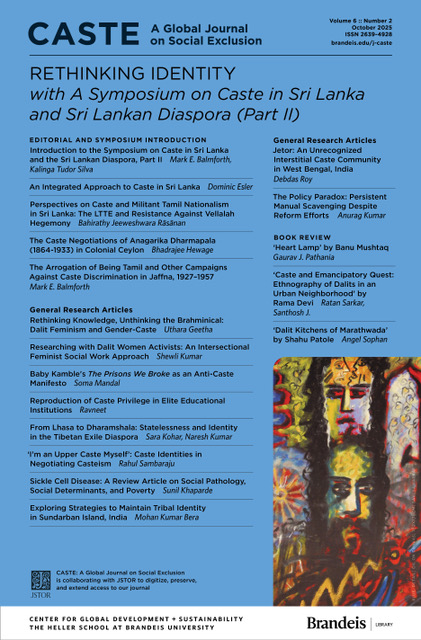Perspectives on Caste and Militant Tamil Nationalism in Sri Lanka: The LTTE and Resistance Against Vellalah Hegemony
Main Article Content
Abstract
By analyzing the intersection of caste and militant Tamil nationalism in Sri Lanka, this article considers whether the Liberation Tigers of Tamil Eelam (LTTE) was a transformative force that disrupted the caste order, including the hegemony of the Vellalah caste. Tamil political leadership in the early twentieth century was dominated by Vellalah elites who carefully upheld caste privileges. The emergence of the LTTE in the late 1970s, led largely by non-Vellalah militants, disrupted this order and asserted a revolutionary Tamil identity transcending caste. Drawing on Vellalah-centered ethnographic fieldwork and testimonies, as well as media accounts and LTTE documents, the study scrutinizes how caste was both repressed and reconstituted within the militant nationalist project. The findings of this study suggest that the LTTE pursued radical measures to dismantle caste hierarchies via outlawing discrimination, imposing egalitarian discipline, valorizing martyrdom, and encouraging inter-caste marriage. These interventions were perceived by Vellalahs as having destabilized their hegemony and enabled wider social and political participation of intermediate and depressed castes. Yet caste has persisted subtly through private practices, silent discourses and enduring social divisions. The study maintains that while the LTTE’s actions destabilized Tamil caste structures, they failed in permanently altering the underlying logic of the caste system, leaving a legacy marked by both disruption and the resilience of caste.
Downloads
Article Details

This work is licensed under a Creative Commons Attribution 4.0 International License.
A. CORRESPONDING AUTHOR’S GRANT OF RIGHTS
The Corresponding Author grants to the Journal, during the full term of copyright and any extensions or renewals of that term, the following:
- An irrevocable non-exclusive right to reproduce, republish, transmit, sell, distribute, and otherwise use the Work in electronic and print editions of the Journal and in derivative works throughout the world, in all languages, and in all media now known or later developed.
- An irrevocable non-exclusive right to create and store electronic archival copies of the Work, including the right to deposit the Work in open access digital repositories.
- An irrevocable non-exclusive right to license others to reproduce, republish, transmit, and distribute the Work under the condition that the Authors are attributed. (Currently this is carried out by publishing the content under a Creative Commons Attribution 4.0 license.)
Copyright in the Work remains with the Authors.
B. CORRESPONDING AUTHOR’S DUTIES
- When distributing or re-publishing the Work, the Corresponding Author agrees to credit the Journal as the place of first publication.
- The Corresponding Author agrees to inform the Journal of any changes in contact information.
C. CORRESPONDING AUTHOR’S WARRANTY
The Corresponding Author represents and warrants that the Work is the Authors’ original work and that it does not violate or infringe the law or the rights of any third party and, specifically, that the Work contains no matter that is defamatory or that infringes any literary or proprietary rights, intellectual property rights, or any rights of privacy. The Corresponding Author also warrants that he or she has the full power to make this agreement, and if the Work was prepared jointly, the Corresponding Author agrees to inform the Authors of the terms of this Agreement and to obtain their written permission to sign on their behalf. The Corresponding Author agrees to hold the Journal harmless from any breach of the aforestated representations.
D. JOURNAL’S DUTIES
In consideration of the Author’s grant of rights, the Journal agrees to publish the Work, attributing the Work to the Authors.
E. ENTIRE AGREEMENT
This agreement reflects the entire understanding of the parties. This agreement may be amended only in writing by an addendum signed by the parties. Amendments are incorporated by reference to this agreement.
